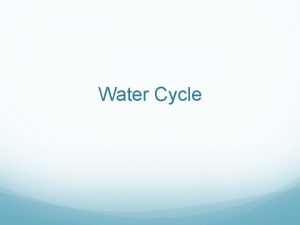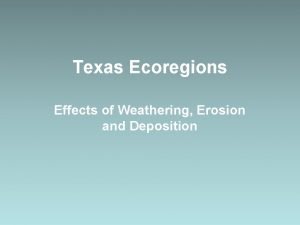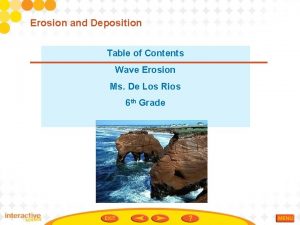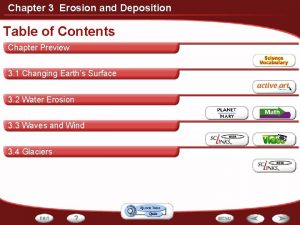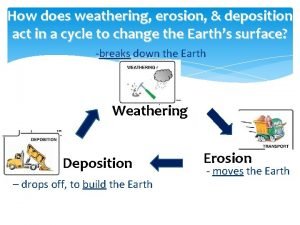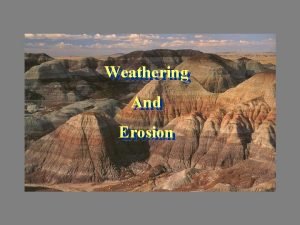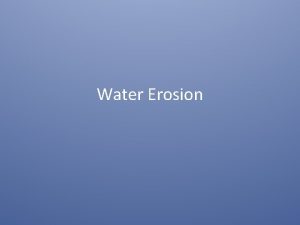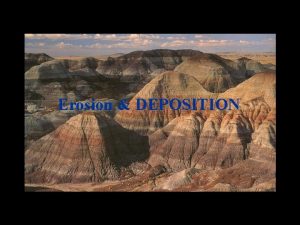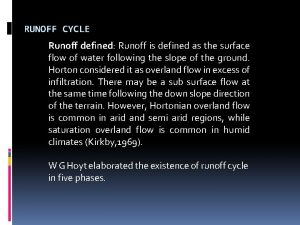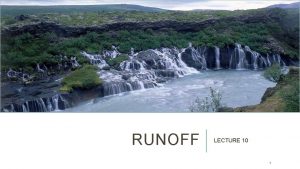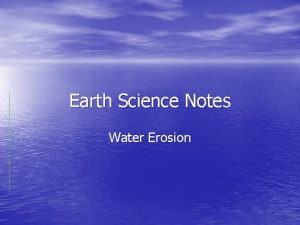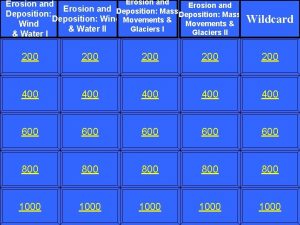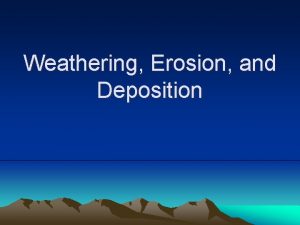Erosion and Deposition Runoff and Erosion Moving water









- Slides: 9

Erosion and Deposition

Runoff and Erosion • Moving water is the major agent of the erosion that has shaped Earth’s land surface. • As water moves over the land, it carries soil particles with it. • Runoff is water that moves over Earth’s surface. • When runoff flows in a thin layer over land, it may cause a type of erosion called sheet erosion.

Amount of Runoff • 1. 2. 3. 4. 5. 6. • The amount of runoff depends on five factors. The amount of rain an area recieves. Vegetation- grasses, shrubs and trees reduce runoff by absorbing water and holding soil in place. The type of soil. Some soil may absorb more water than others. The shape of the land. Land that is steeply sloped has more runoff than flatter land. How people use the land. A paved parking lot absorbs no water, so all the rain that falls on it becomes runoff. Runoff also increases when farmers cut down crops. Deserts have little rainfall, they have high runoff and erosion because they have fewer plants. In wet areas, runoff and erosion may be low because there are more plants to protect the soil.

Water Erosion • Rainwater running off land carries away sediment, leaving behind an eroded path called a rills. Over time, as water keeps flowing in the rills, it widens and deepens to form a gully. Gullies join together to form a larger channel called stream. A stream is a channel along which water is continually flowing down a slope. Unlike gullies, streams never dry. • A stream grows into a larger stream or river by receiving water from the tributaries. A tributary is a stream or river that flows into a larger river. For example , the Missouri and Ohio rivers are tributaries of the Mississippi River. • A watershed is the area from which a river and its tributaries collect there water. • Great Rivers, such as the Mississippi River, deposit the sediment they carry where they enter the ocean, forming a delta. • Moving water affects sediment at the shore. Ocean waves and currents carry sand off one beach, and deposit it later on another beach somewhere else.

Erosion by Rivers • As a river flows from the mountains to the sea, the river forms a variety of features. Through erosion , a river creates valleys, waterfalls, flood plains, meanders and oxbow lakes.

The Force of Moving Water • Weathering breaks rocks into smaller pieces. These pieces can be swept away through erosion. Erosion takes away land in one place and builds land in another. When moving water, glaciers, waves, wind or gravity drops a load of Earth’s materials in a new place, it is called deposition. • Gravity is the force that moves rock and other materials downhill. Gravity causes mass movements. The different types of mass movements include landslides, mudflows, slump and creep.

Ice • Rivers and sheets of year round ice called glaciers slowly move over land. As they travel, glaciers can move boulders the size of houses, as well as smaller sediments. Over time, the rocks and sediments carried by moving glaciers can carve deepen valleys • A continental glacier is a glacier that covers much of a continent or large island. • A valley glacier is a long, narrow glacier that forms when snow and ice build up high in a mountain valley.

Wind • Fast-moving wind can carry sand dust that scour and weather the surfaces they strike. Wind erosion is the greatest in dry areas, such as deserts, where there is little water to hold soil particles together or trees to block the winds path. When the wind slows, it drops its load. This is how sand dunes are built.

Gravity • Gravity is the underlying force of erosion and deposition. It causes water and glaciers to move downhill, particles carried by water and wind to settle to a stream or lake bed and to the ground. Gravity can also directly cause erosion in the form of landslides and mudflows.


